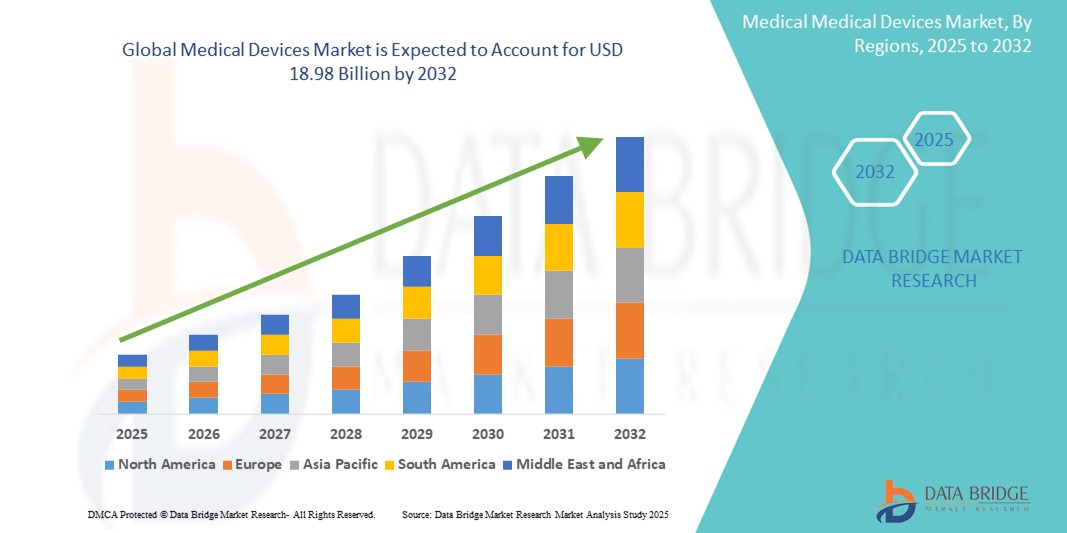Transforming Healthcare: The Global Medical Devices Market and Its Future Outlook
Global Medical Devices Market Size, Share, and Trends Analysis Report – Industry Overview and Forecast to 2032
- The global medical devices market size was valued at USD 12.56 billion in 2024 and is expected to reach USD 18.98 billion by 2032, at a CAGR of 5.30% during the forecast period
https://www.databridgemarketresearch.com/reports/global-medical-devices-market

The global medical devices market stands as one of the most dynamic and essential sectors in modern healthcare, driving advancements that enhance patient outcomes, streamline clinical procedures, and improve quality of life. As technological innovations accelerate, medical devices have become the cornerstone of diagnostic precision, therapeutic efficiency, and preventive healthcare worldwide. From simple instruments such as syringes and thermometers to complex devices like MRI machines, robotic surgical systems, and implantable cardiac defibrillators, the industry’s diversity underscores its significance across healthcare systems.
Market Overview
The medical devices market has witnessed rapid growth over the past decade, fueled by rising healthcare expenditures, increasing prevalence of chronic diseases, aging populations, and expanding access to healthcare services in emerging economies. The integration of digital technologies such as artificial intelligence (AI), Internet of Things (IoT), and data analytics has transformed device functionality, enabling real-time monitoring, predictive diagnostics, and personalized treatment plans.
The market encompasses a wide range of products categorized into diagnostic devices, therapeutic devices, monitoring equipment, surgical instruments, and specialized implants. With governments and private sectors heavily investing in healthcare infrastructure, the demand for efficient and reliable medical devices continues to surge.
Key Growth Drivers
Technological Advancements:
Continuous innovation has been the foundation of the medical devices market. Breakthroughs in biotechnology, nanotechnology, and material science have led to the development of minimally invasive and smart devices. For instance, wearable health trackers and remote monitoring systems are now pivotal in preventive care and chronic disease management.
Rising Burden of Chronic Diseases:
Non-communicable diseases such as diabetes, cardiovascular disorders, and cancer are on the rise globally. This trend has heightened the demand for diagnostic and treatment devices that can provide early detection and efficient management. For example, glucose monitoring devices, pacemakers, and infusion pumps have become critical components of long-term care.
Aging Population:
The growing geriatric population, particularly in developed regions, is a key driver of market expansion. Older adults are more susceptible to chronic conditions, necessitating frequent medical interventions and the use of assistive and diagnostic devices.
Digital Health Integration:
The convergence of medical devices with digital health platforms has revolutionized patient care. Remote patient monitoring, telemedicine, and connected healthcare ecosystems allow physicians to collect continuous health data, improving decision-making and reducing hospital readmissions.
Growing Healthcare Investments:
Governments across developed and developing economies are focusing on healthcare reforms and expanding access to quality care. Increased investments in hospitals, clinics, and diagnostic centers have created a robust environment for medical device adoption.
Market Segmentation
The global medical devices market is segmented by product type, application, end-user, and region.
By Product Type: Diagnostic imaging systems, in-vitro diagnostic devices, patient monitoring equipment, surgical instruments, cardiovascular devices, orthopedic implants, and dental devices are some major categories.
By Application: The applications include cardiology, orthopedics, neurology, oncology, ophthalmology, and general surgery.
By End-User: Hospitals, ambulatory surgical centers, home healthcare, and clinics represent the key end-users of medical devices.
By Region: North America dominates the global market, followed by Europe and Asia-Pacific. The Asia-Pacific region is expected to exhibit the fastest growth due to rapid healthcare modernization and rising patient awareness.
Regional Insights
North America holds a major share of the market, attributed to advanced healthcare infrastructure, strong regulatory frameworks, and the presence of leading manufacturers. The United States, in particular, continues to lead innovation with significant investment in research and development.
Europe follows closely, driven by robust public health systems and high adoption of technologically advanced devices. The European Union’s emphasis on safety standards and innovation-friendly policies further strengthens the market.
Asia-Pacific is emerging as the most promising region due to its expanding middle-class population, increasing healthcare spending, and growing medical tourism. Countries like China, India, and Japan are investing heavily in healthcare infrastructure, offering lucrative opportunities for market players.
Latin America, the Middle East, and Africa are also experiencing steady growth, fueled by improving healthcare access and rising awareness of advanced medical technologies.
Challenges in the Market
Despite its strong growth trajectory, the medical devices market faces several challenges:
Regulatory Barriers: Compliance with stringent regulatory frameworks often delays product approvals and market entry. Manufacturers must adhere to regional standards set by authorities such as the FDA (U.S.) and EMA (Europe).
High Costs: Advanced devices require substantial investment in research, production, and maintenance, limiting accessibility in low-income regions.
Data Security Concerns: With the growing adoption of connected devices, cybersecurity risks have become a major concern for patient data protection.
Supply Chain Disruptions: Global crises, such as pandemics or geopolitical tensions, can disrupt manufacturing and distribution, affecting product availability.
Emerging Trends
Wearable and Portable Devices:
The rise of fitness trackers, biosensors, and wearable diagnostic tools is reshaping patient engagement and healthcare delivery.
Artificial Intelligence and Machine Learning:
AI-powered imaging systems and diagnostic algorithms are improving accuracy and speed in detecting diseases such as cancer and cardiovascular conditions.
3D Printing in Medical Devices:
3D printing technology is revolutionizing prosthetics, implants, and surgical instruments by enabling customized and cost-effective manufacturing.
Home Healthcare Devices:
Growing demand for convenient, at-home healthcare solutions is driving the adoption of portable diagnostic and therapeutic devices, particularly in post-operative and elderly care.
Sustainability and Green Medical Devices:
The industry is increasingly adopting eco-friendly materials and sustainable production processes to reduce environmental impact.
Competitive Landscape
The medical devices market is highly competitive, with major players such as Medtronic, Siemens Healthineers, Johnson & Johnson, GE Healthcare, Philips, and Abbott Laboratories leading innovation. These companies focus on product diversification, mergers and acquisitions, and strategic partnerships to expand their global presence. Startups specializing in AI-driven devices and wearable health tech are also entering the market, contributing to a more dynamic competitive environment.
Future Outlook
The future of the medical devices market is promising, with continuous innovation reshaping the healthcare landscape. As digitalization and precision medicine continue to advance, the demand for intelligent and connected medical devices will soar. Governments’ increasing emphasis on healthcare quality, patient safety, and disease prevention will further drive market growth.
Moreover, the integration of advanced analytics and automation will enable real-time data-driven decision-making, improving patient outcomes while optimizing operational efficiency. The shift toward value-based healthcare models will also encourage the adoption of cost-effective and outcome-oriented devices.
Conclusion
The global medical devices market is evolving rapidly, redefining how healthcare is delivered, monitored, and managed. With technology bridging the gap between patients and providers, the industry is poised to enter an era of personalized, predictive, and preventive care. While challenges such as regulation and cost persist, the overall trajectory remains upward. The continued collaboration between technology developers, healthcare institutions, and policymakers will be crucial in unlocking the full potential of medical devices in shaping a healthier, more connected future.
Browse More reports :
Global Health and Wellness Food Market
Global Industrial Water Treatment Chemical Market
India Health and Wellness Food Market
Global Cosmetics Market
Global Biochar Market
Global Black Soldier Fly Market
Middle East and Africa Cosmetics Market
Global Climbing Gym Market
Global Intelligent Transportation System (ITS) Market
Global Medical Devices Market
Global Parkinson’s Disease Treatment Market
Global Perovskite Solar Cell Market
Global Nanomedicine Market
West Africa Dairy Market
Europe Health and Wellness Food Market
Global Luxury Watch Market
Global Microalgae Market

- Art
- Causes
- Crafts
- Dance
- Drinks
- Film
- Fitness
- Food
- Spellen
- Gardening
- Health
- Home
- Literature
- Music
- Networking
- Other
- Party
- Religion
- Shopping
- Sports
- Theater
- Wellness


